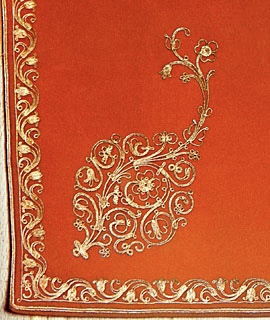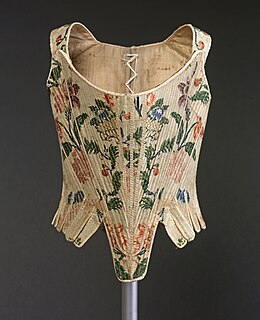
Embroidery is the craft of decorating fabric or other materials using a needle to apply thread or yarn. Embroidery may also incorporate other materials such as pearls, beads, quills, and sequins. In modern days, embroidery is usually seen on caps, hats, coats, blankets, dress shirts, denim, dresses, stockings, and golf shirts. Embroidery is available with a wide variety of thread or yarn colour.

The Royal School of Needlework (RSN) is a hand embroidery school in the United Kingdom, founded in 1872 and based at Hampton Court Palace since 1987.

Dame Zandra Lindsey Rhodes,, is an English fashion and textile designer. Her early education in fashion set the foundation for a career in the industry creating textile prints. Rhodes designed garments for Diana, Princess of Wales and numerous celebrities such as rock stars Freddie Mercury and Marc Bolan. In addition to designing garments, she designed textiles for interiors, featuring her prints on furniture and homewares. In 2003 Rhodes founded the Fashion and Textile Museum in London.

A yashmak, yashmac or yasmak is a Turkish type of veil or niqab worn by some Muslim women to cover their faces in public. Today there is almost no usage of this garment in Turkey.

Byzantine emperors dress changed considerably over the thousand years of the Empire, but was essentially conservative. The Byzantines liked colour and pattern, and made and exported very richly patterned cloth, especially Byzantine silk, woven and embroidered for the upper classes, and resist-dyed and printed for the lower. A different border or trimming round the edges was very common, and many single stripes down the body or around the upper arm are seen, often denoting class or rank. Taste for the middle and upper classes followed the latest fashions at the Imperial Court. As in the West during the Middle Ages, clothing was very expensive for the poor, who probably wore the same well-worn clothes nearly all the time; this meant in particular that any costume owned by most women needed to fit throughout the full length of a pregnancy.

Antoin Sevruguin was a photographer in Iran during the reign of the Qajar dynasty (1785–1925).

The National Museum of Ethnology, is an ethnographic museum in the Netherlands located in the university city of Leiden. As of 2014, the museum, along with the Tropenmuseum in Amsterdam, and the Africa Museum in Berg en Dal, together make up the National Museum of World Cultures.

The study of the history of clothing and textiles traces the development, use, and availability of clothing and textiles over human history. Clothing and textiles reflect the materials and technologies available in different civilizations at different times. The variety and distribution of clothing and textiles within a society reveal social customs and culture.

Fashion in 15th-century Europe was characterized by a series of extremes and extravagances, from the voluminous robes called houppelandes with their sweeping floor-length sleeves to the revealing doublets and hose of Renaissance Italy. Hats, hoods, and other headdresses assumed increasing importance, and were draped, jewelled, and feathered.

Fashion in fourteenth-century Europe was marked by the beginning of a period of experimentation with different forms of clothing. Costume historian James Laver suggests that the mid-14th century marks the emergence of recognizable "fashion" in clothing, in which Fernand Braudel concurs. The draped garments and straight seams of previous centuries were replaced by curved seams and the beginnings of tailoring, which allowed clothing to more closely fit the human form. Also, the use of lacing and buttons allowed a more snug fit to clothing.

Palestinian costumes are the traditional clothing worn by Palestinians. Foreign travelers to Palestine in the 19th and early 20th centuries often commented on the rich variety of the costumes worn, particularly by the fellaheen or village women. Many of the handcrafted garments were richly embroidered and the creation and maintenance of these items played a significant role in the lives of the region's women.
Willem Vogelsang is the deputy director of the International Institute for Asian Studies at the University of Leiden in the Netherlands. He is also a Colonel in the Dutch armed forces as Project Coordinator for Cultural Affairs, part of the Civil Military Cooperation (CIMIC).

The Museu Tèxtil i d'Indumentària, in English Textile and Clothing Museum, is a museum opened on 1982 and located in the Palau Reial de Pedralbes in Barcelona. The museum possesses countless objects and pieces of major artistic and historical value that make up their collections of garments, fabrics and jewellery. Regarding their collection of clothes, the museum allows you to take a journey through the history of textiles, from the 16th century right up to the modern day. The museum's collections include Coptic, Hispano-Arab, Gothic and Renaissance fabrics, as well as embroidery, a section on lacework and a collection of prints. Also worth mentioning is the jewelry collection, comprising approximately five hundred pieces that were made and produced in Spain.

An arakhchin is a traditional Azerbaijani and Armenian flat top skull cap headdress, worn by both men and women in the past.

Eugénie Luce (1804-1882) was a French educator, who founded the first French/Arab school for Muslim girls the Luce Ben Aben School in Algiers, Algeria, in 1845.
The International Qajar Studies Association (IQSA) is an association specialised in the study of the Qajar Era and the Qajar dynasty. The association organises conferences, study days, lectures, cultural events and exhibitions, publishes books, a Journal and a regular newsletter, runs a Studies and Documentation Centre and brings together scholars from across the globe. The association also assisted in establishing the Harvard University project Women's World in Qajar Iran: A digital Archive and Website and co-funded the foundation of the Centre for the Study of the International Relations of the Middle East and North Africa (Cirmena) of the University of Cambridge.

A national liberation skirt or national celebration skirt is a style of skirt, handmade of patchwork and embroidery, in celebration of Dutch Liberation Day on 5 May 1945. The style was invented by resistance fighter and feminist Mies Boissevain-van Lennep. The feestrok has been described as "a female mode of political expression ... [which] explicitly linked gender to the reconstruction of a ravaged country and the general striving for 'breakthrough' and social renewal."

Beryl Dean MBE was a British embroiderer. She was known for rejecting the traditional Victorian designs and for creating her own contemporary embroidery designs.

Feed sack dresses, flour sack dresses, or feedsack dresses were a common article of clothing in rural US and Canadian communities from the late 19th century through the mid 20th century. They were made at home, usually by women, using the cotton sacks in which flour, sugar, animal feed, seeds, and other commodities were packaged, shipped, and sold. They became an iconic part of rural life from the 1920s through the Great Depression, World War II, and post-World War II years.

The jibba or jibbah is a long coat worn by Muslim men. It was the garment worn by the followers of the Mahdī during the Mahdist War in Sudan at the end of the 19th century. Muhammad Ahmad proclaimed himself al-Mahdī al-Muntaẓar, successor of the Prophet Muhammad, in 1881. He exhorted his followers to join a jihad against the Ottoman-Egyptian occupation of Sudan.



















